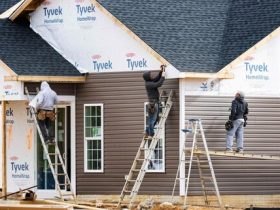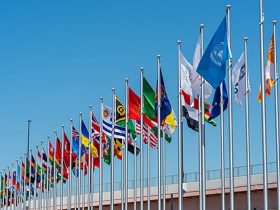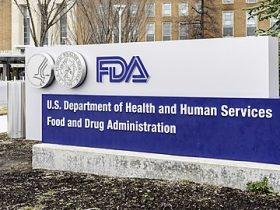Marc Joffe
Federal, state, and local governments are being called upon to support struggling transit agencies to meet climate change goals. But spending money on transit is not necessarily the best way to reduce greenhouse gas emissions. In most of the United States, people are reluctant to or unable to use trains and buses to get to the destinations that matter to them. As a result, per rider operating and capital costs are quite high for many systems.
Faltering Ridership
Ridership data from reports compiled by the American Public Transit Association shows that passenger trips peaked in 2014 at 10.7 billion. By 2019, ridership had fallen 8% to 9.9 billion. It then cratered during the pandemic and recovered modestly in 2022.
To better chart Americans’ propensity to use public transit, I divided the ridership totals by annual population estimates published by USAFacts. Per capita transit use peaked at 35 rides per US resident in 2008 (a year of unusually high gas prices) and had fallen to just over thirty rides per resident prior to the pandemic. In 2022, ridership remained below 19 trips per resident.
Given longer term trends, it seems likely that total transit utilization will never return to 2019 levels, and that once they have reached a post‐pandemic equilibrium, should not be expected to grow, at least on a per capita basis.
High‐Cost Systems
The Federal Transit Administration’s National Transit Database (NTD) contains operating cost data by system but is provided on a lagged basis. For fiscal year 2021, NTD data shows aggregate operating expenses of $47.4 billion or $10.87 per passenger of which only $1.40 were covered by fares, yielding a farebox recovery ratio of 12.9%.
Because FY 2021 (which, depending on the transit provider, may contain several months from calendar year 2020) represented a ridership trough, we should expect costs per passenger and farebox recoveries to improve substantially in FY 2022 and 2023.
But NTD’s operating cost data does not incorporate the full cost of transporting passengers. And once we move beyond the Northeast and Chicago, overall costs per passenger can reach very high levels.
An example is the San Francisco Bay Area Rapid Transit (BART) system. NTD data for 2021 show $633 million in operating expenses, 18 million trips, and a cost per trip of $35.46. But BART’s 2021 audited financial statement shows $1.175 billion in operating expenses implying a cost per trip of $65.86. Among the costs included in the financial report but excluded by NTD is depreciation.
In the more normal year of FY 2022, BART had operating expenses of $1.226 billion (per its 2022 audit) and 38 million trips yielding a fully loaded cost per trip of $32.07.
Smaller rail systems can have even higher costs per trip. An example is Sonoma‐Marin Area Rail Transit (SMART), which runs trains between Sonoma County Airport and the ferry terminal in Larkspur, CA. In FY 2022, its audit showed operating expenses of $48 million covering 354 thousand trips, thus yielding a cost per trip of $134.74.
Expensive Capital Projects
Adding riders by extending transit systems is a costly exercise that may not make financial or climate sense. Larger projects such as the Second Avenue Subway (costing $4.6 billion) and Grand Central Madison ($12 billion) have been thoroughly examined. But projects outside the Northeast promise to yield even worse results.
In Santa Clara County, the Valley Transit Authority (VTA) has raised $530 million to extend a light‐rail line 2.4 miles and make related improvements. Projected daily boardings across the three stations served by the station are expected to reach 4,534 by the year 2043. But even this paltry ridership figure is misleading.
As we learn from Table 18 of VTA’s Supplementary Transportation Analysis, there would still be 2,322 boardings at the current terminal station, Alum Rock, if the extension was not built. Further, 896 of the projected light rail boardings would be from bus riders switching to the new transit mode. So, on net, this $530 million light‐rail extension is expected to add only 1,316 daily transit rides.
Finally, these ridership projections were developed before the pandemic and do not appear to have been updated since. Given the sharp decline in VTA light rail ridership since early 2020, an updated forecast would likely show fewer than a thousand added rides daily. A subset of those would replace car trips.
Spending over half a billion dollars to replace just a few hundred car trips per day is an inefficient way to save the planet. Assuming, generously, that the light‐rail extension would replace a thousand car trips daily and that the infrastructure has a useful life of forty years, the capital cost per car trip replaced would be over $36,000, enough to buy everyone an electric vehicle!
Alternatives
Continued large transit investments are unlikely to replace a substantial proportion of gasoline‐powered car trips and the greenhouse gas emissions they cause. Policymakers concerned about the transportation sector’s impact on climate change should consider more cost‐effective alternatives.
For example, if more people live within a short distance of shopping, dining, and entertainment activities, they may choose walking or biking over driving. One way to shorten travel lengths is to relax zoning laws to encourage mixed use development.
Meanwhile, car buyers are increasingly choosing electric vehicles. In January 2023, electric vehicles accounted for seven percent of US auto sales. The Inflation Reduction Act’s EV tax credits are contributing to the demand for these vehicles. But the credits are limited to vehicles whose final assembly is in North America. If car buyers could also use the credits for often‐cheaper EVs imported from overseas, they would be more likely to choose an EV over internal combustion vehicles (for EVs to be an effective climate solution sufficient clean electricity needs to be available and greenhouse gas emissions during the EV production process should be limited).
Finally, cities can reduce idling at intersections by introducing smart traffic lights that change based on the flow of traffic rather than at fixed intervals. The Department of Energy has estimated that eliminating unnecessary idling “would be the same as taking 5 million vehicles off the roads”.
With all this said, transit can make sense in densely populated cities like New York and Chicago where infrastructure has already been built and operating costs per rider are relatively low. But transit does not work everywhere, and policymakers should be cautious about relying on it as a universal climate solution.





